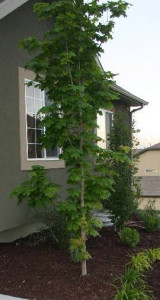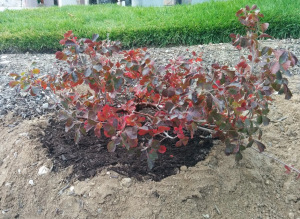
2″ Caliper when planted

5″ caliper six-years later
We planted three Columnar Norway Maples in our yard. They were about 2″ caliper, but the photos show they grew well in 6 years. I would not suggest planting grass right up to the trunk. Two were planted in grass and one was planted in flower beds. The tree that didn’t have to compete with the grass was much larger than the other two and looks healthier. These trees require very little attention otherwise and the leaves are beautiful. We did have some years with lots of bugs on them and ended up spraying them.
2015 update – Last year we planted a Columnar Norway Maple, 2″ caliper, in a very poor spot. We carved the hole in white/gray clay. It was so hard we could only carve away at it – a pick would only make a 1/2″ dent in it. Filling the hole with water to soften it up didn’t work, it was still full of water the next day. I really thought we might have to move that tree, but it is growing great! It has put on over 3′ of growth. It is on drip and gets regular water. Other than the really late hard frost that deformed some of the leaves, it looks very healthy.






